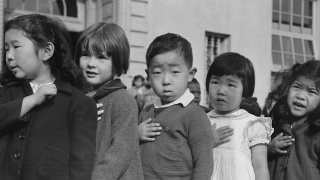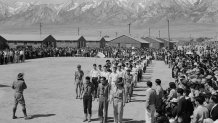
Samantha Sumiko Pinedo and her grandparents file into a dimly lit enclosure at the Japanese American National Museum and approach a massive book splayed open to reveal columns of names. Pinedo is hoping the list includes her great-grandparents, who were detained in Japanese American incarceration camps during World War II.
“For a lot of people, it feels like so long ago because it was World War II. But I grew up with my Bompa (great-grandpa), who was in the internment camps,” Pinedo says.
A docent at the museum in Los Angeles gently flips to the middle of the book — called the Ireichō — and locates Kaneo Sakatani near the center of a page. This was Pinedo’s great-grandfather, and his family can now honor him.
On Feb. 19, 1942, following the attack by Imperial Japan on Pearl Harbor and the United States' entry to WWII, President Franklin D. Roosevelt signed Executive Order 9066 authorizing the incarceration of people of Japanese ancestry who were considered potentially dangerous.
Get San Diego local news, weather forecasts, sports and lifestyle stories to your inbox. Sign up for NBC San Diego newsletters.
From the extreme heat of the Gila River center in Arizona, to the biting winters of Heart Mountain in Wyoming, Japanese Americans were forced into hastily built barracks, with no insulation or privacy, and surrounded by barbed wire. They shared bathrooms and mess halls, and families of up to eight were squeezed into 20-by-25 foot (6-by-7.5 meter) rooms. Armed U.S. soldiers in guard towers ensured nobody tried to flee.
Approximately two-thirds of the detainees were American citizens.
When the 75 holding facilities on U.S. soil closed in 1946, the government published Final Accountability Rosters listing the name, sex, date of birth and marital status of the Japanese Americans held at the 10 largest facilities. There was no clear consensus of who or how many had been detained nationwide.

Duncan Ryūken Williams, the director of the Shinso Ito Center for Japanese Religions and Culture at the University of Southern California, knew those rosters were incomplete and riddled with errors, so he and a team of researchers took on the mammoth task of identifying all the detainees and honoring them with a three-part monument called “Irei: National Monument for the WWII Japanese American Incarceration.”
U.S. & World
“We wanted to repair that moment in American history by thinking of the fact that this is a group of people, Japanese Americans, that was targeted by the government. As long as you had one drop of Japanese blood in you, the government told you you didn’t belong,” Williams said.
The Irei project was inspired by stone Buddhist monuments called Ireitōs that were built by detainees at camps in Manzanar, California, and Amache, Colorado, to memorialize and console the spirits of internees who died.
The first part of the Irei monument is the Ireichō, the sacred book listing 125,284 verified names of Japanese American detainees.
“We felt like we needed to bring dignity and personhood and individuality back to all these people," Williams said. "The best way we thought we could do that was to give them their names back.”
The second element, the Ireizō, is a website set to launch on Monday, the Day of Remembrance, which visitors can use to search for additional information about detainees. Ireihi is the final part: A collection of light installations at incarceration sites and the Japanese American National Museum.
Williams and his team spent more than three years reaching out to camp survivors and their relatives, correcting misspelled names and data errors and filling in the gaps. They analyzed records in the National Archives of detainee transfers, as well as Enemy Alien identification cards and directories created by detainees.
“We feel fairly confident that we’re at least 99% accurate with that list,” Williams said.
The team recorded every name in order of age, from the oldest person who entered the camps to the last baby born there.
Williams, who is a Buddhist priest, invited leaders from different faiths, Native American tribes and social justice groups to attend a ceremony introducing the Ireichō to the museum.

Crowds of people gathered in the Little Tokyo neighborhood to watch camp survivors and descendants of detainees file into the museum, one by one, holding wooden pillars, called sobata, bearing the names of each of the camps. At the end of the procession, the massive, weighty book of names was carried inside by multiple faith leaders. Williams read Buddhist scripture and led chants to honor the detainees.
Those sobata now line the walls of the serene enclosure where the Ireichō will remain until Dec. 1. Each bears the name — in English and Japanese — of the camp it represents. Suspended from each post is a jar containing soil from the named site.
Visitors are encouraged to look for their loved ones in the Ireichō and leave a mark under their names using a Japanese stamp called a hanko.
The first people to stamp it were some of the last surviving camp detainees.
So far, 40,000 visitors have made their mark. For Williams, that interaction is essential.
“To honor each person by placing a stamp in the book means that you are changing the monument every day,” Williams said.

Sharon Matsuura, who visited the Ireichō to commemorate her parents and husband who were incarcerated in Camp Amache, says the monument has an important role to play in raising awareness, especially for young people who may not know about this harsh chapter in America's story.
“It was a very shameful part of history that the young men and women were good enough to fight and die for the country, but they had to live in terrible conditions and camps," Matsuura says. "We want people to realize these things happened.”
Many survivors remain silent about what they endured, not wanting to relive it, Matsuura says.
Pinedo watches as her grandmother, Bernice Yoshi Pinedo, carefully stamps a blue dot beneath her father's name. The family stands back in silence, taking in the moment, yellow light casting shadows from the jars of soil on the walls.
Kaneo Sakatani was only 14 when he was detained in Tule Lake, in far northern California.
“It’s sad,” Bernice says. “But I feel very proud that my parents’ names were in there.”




